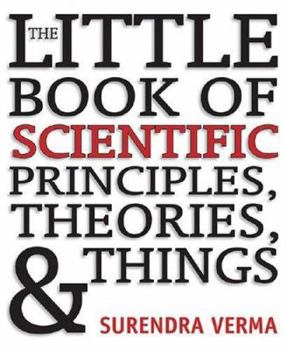The Little Book of Scientific Principles, Theories, & Things
Select Format
Select Condition 
Book Overview
What is Pythagoras' Theorem? Who developed the World Wide Web? What is the difference between circadian rhythms and the popular concept of biorhythms? Find out the answers here, where serious science is presented simply, clearly, and chronologically for the layperson. This fascinating and jam-packed little book explains 175 of the most important laws, principles, equations, and theories that form the foundation of the field as we know it. All the great names are featured, including Galileo, Newton, Darwin, and Einstein, as well as more recent contributors such as Rachel Carson, James Lovelock, and Stephen Hawking. It's an invaluable resource.
Format:Paperback
Language:English
ISBN:1402738706
ISBN13:9781402738708
Release Date:April 2006
Publisher:Sterling Publishing (NY)
Length:224 Pages
Weight:0.80 lbs.
Dimensions:0.7" x 5.5" x 6.7"
Customer Reviews
2 ratings
Quick read comprehensive summary
Published by Thriftbooks.com User , 17 years ago
This is the perfect summary of scientific knowledge in one easy to read book. It is presented in a historical timeline, showing the progression of discovery. Virtually everything is there, but not too much is there. It is also useful as a reference. It includes just the right formulas, and beyond that provides enough information for an internet lookup.
A Compact Mini-Encyclopedia of Essential Scientific Concepts
Published by Thriftbooks.com User , 18 years ago
As a science teacher, I have found this book invaluable as a reference and refresher book. So much information is packed into just one little volume! It contains 175 one-page entries of concepts in math and science. Each concept is labeled by the year of discovery, the discover(s), and the nationality of the discover(s). All descriptions are concise and almost always well explained and illustrated. The math concepts include the Pythagorean Theorem and the Fibonacci numbers. Scientific concepts and discoveries include the Archimedes Principle, Eratosthenes and his measurement of the earth's sphericity over 2400 years ago, Snell's Law, Pascal's Law (as applied today in hydraulics), Boyle's Law, Hooke's Law (used today in engineering), Bernoulli's Principle (making airplane flight possible), Bode's Law (of planetary intervals), Howard's cloud types, Avogadro's Law and Number (standard in chemistry class), Gauss Law, the Foucault pendulum (proof of earth's rotation), the benzene ring as inspired by Kekule's dream of the snake biting its own tail, Polish-born Marie Curie's discovery of Polonium, the pH scale, Hubble's Law, the Richter Scale, and much more. Attention is also devoted to newer concepts such as chaos theory and the buckyball molecular morphology of elemental carbon. This little book is a must for scientifically-minded readers!





